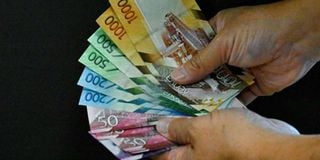Reprieve for importers as shilling strengthens

The Kenyan shilling has firmed up against the US dollar, easing the cost incurred by traders when shipping goods into the country.
What you need to know:
- The shilling was hit hard by the shutdown of the tourism industry, which is among the country's leading source of foreign exchange.
- The shilling was hit hard by the shutdown of the tourism industry, which is among the country's leading source of foreign exchange.
The Kenyan shilling has firmed up against the US dollar, easing the cost incurred by traders when shipping goods into the country.
Traders looking to place import orders yesterday were buying the greenback, the widely accepted currently in the international market, at the average of 108.79 units against the dollar as quoted by the Central Bank of Kenya (CBK).
This was a substantial saving from the average 111.59 they were forced to fork out last week.
The currency appreciation is attributed to falling demand for the dollar in the market due to minimal activity as the year comes to an end.
The shilling was hit hard by the shutdown of the tourism industry, which is among the country's leading source of foreign exchange.
“The biggest news was the shilling which closed at 108.80 on Monday, with few banks unwinding long positions on the dollar which had ripple effect on the market and saw a massive sell off from banks holding long positions including clients holding dollar deposits,” AIB-AXYS Africa Capital said on their fixed note for December 23.
Corporate demand
“With little corporate demand in the market our view is this would be a good time to take positions in preparations for the New Year.”
The shilling has lost over 8.8 percent since average of 101.08 in January owing to pressure from oil and merchandise importers who were buying dollars for purchase of stocks especially on easing of travel restrictions in July.
The high demand lead to increase in cost of imported goods such as petroleum, motor vehicles and clothing and footwear.
The weakening for most part of the year prompted the CBK to move to strengthen the shilling by mopping liquidity through the interbank market.
The currency is expected to be weighed down in the coming year due to demand for dollars in anticipation of the economy fully opening up and the increasing political noise.
The dollar is also expected to head into a bullish trend in the first two quarters due to increase in the global risk aversion by investors, weakening the shilling.





